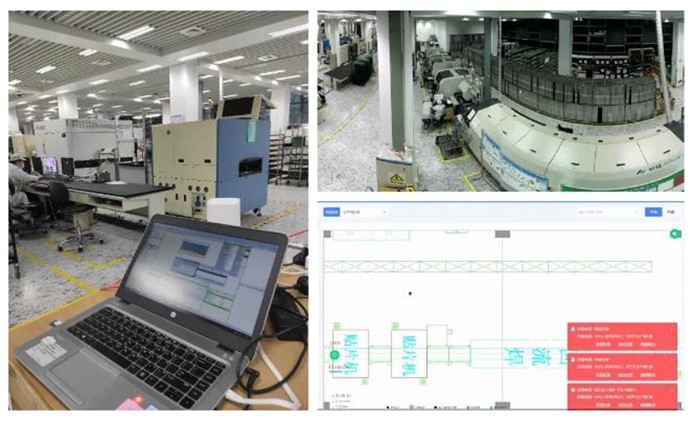Joint efforts with CMRI to complete a 4.9GHz band 5G small cell pilot
Recently, the joint pilot application of 4.9GHz small cells conducted by China Mobile Research Institute, China Mobile Zhejiang, and H3C has achieved significant progress. The three parties deployed on-site at the High-end Product and Prototype Manufacturing Workshop in the Hangzhou Trial Production Center, collaboratively completing the verification testing of 4.9GHz small cells based on the SA architecture in vertical industry scenarios and achieving several breakthrough results.
The 4.9GHz small cells and the External Interface Expansion Unit MAU used in this application trial follow the full set of enterprise standards of China Mobile, with design provided by China Mobile Research Institute and trial production by H3C. The 4.9G pRRU supports 4 channels, boasting advantages such as large coverage, high performance, and flexible configuration of uplink frame structure. It can also connect various business access modules, such as Wi-Fi, UWB, Bluetooth, Zigbee, RFID, and more, through the external interface expansion unit, catering to the networking needs of various vertical industries like 5G public networks and industrial Internet to the greatest extent.
The selected site for the trial is a typical indoor multi-level workshop with an area of approximately 4000 square meters, representing the industrial manufacturing attributes. The testing focused on verifying the coverage capability of 4.9GHz small cells, network performance, and performance comparison with 2.6GHz small cells. Additionally, solution testing and business demonstrations were conducted in typical scenarios widely used in industrial settings, such as 5G+UWB indoor high-precision positioning, ultra-high-definition video, and data feedback for temperature and humidity sensing in factory areas.
High Performance, Low Latency
In terms of indoor performance, the 4x4 design ensures excellent coverage even in the 4.9GHz frequency band. Particularly, under the configuration of a dedicated uplink frame structure, the 64QAM uplink rate can reach over 400Mbps. Compared to the conventional uplink rate under 5ms single-cycle slot configuration, this represents a 2-3 times increase in the uplink rate and a reduction of over 50% in latency. This enables seamless real-time uploading of multiple ultra-high-definition videos in factory scenarios, addressing the urgent demand for high-bandwidth uplink carriers in current vertical industries.
Quick Installation, Flexible Deployment
In terms of deployment and implementation indoors, the 4.9GHz small cells and MAU fully leverage the characteristics of quick installation, high flexibility, and minimal spectrum interference. The on-site engineering implementation and coverage optimization for the 4000-square-meter workshop were completed in less than two days. Benefiting from the small size and light weight of the 4.9GHz small cells, as well as the use of photonic hybrid cables/network cables for power supply and support for expandable interfaces, it aligns well with the network positioning in vertical industries: one-time wiring, quick installation, rapid delivery, and flexible expansion. It can be a preferred solution for 5G network applications in vertical industries such as industrial manufacturing with many indoor scenarios.
Personalized Networking, High-Security Control
In terms of personalized networking, the unique external expansion unit design of the 4.9GHz small cells connects four UWB modules, testing and validating the fusion solution for 5G+UWB indoor high-precision positioning. In scenarios where 4.9GHz small cells are installed, there is no need for additional external power supply. Simply by connecting through expandable network cables and UWB modules, it can simultaneously meet the requirements for 5G network coverage and high-precision location management of personnel/mobile devices with up to 10-centimeter accuracy within the UWB coverage area. It provides multi-access fusion networking and integrated support for multiple business needs. The experiment used a local lightweight core network and a common resource pool for MEC edge computing applications through the general resource pool of 5G cloud base stations, maximizing the assurance of vertical industry customers for business data security, local operation and maintenance, and edge computing business requirements.

Industrial Scene Testing Site (Left) and Synchronized Image from 5G Ultra-High-Definition Camera (Right-Upper), along with Extended UWB High-Precision Positioning (Right-Lower)
The successful completion of this 4.9GHz small cell pilot application will become a model of cooperation between H3C and China Mobile in exploring vertical industry scenarios. In the future, H3C will continue to collaborate closely with China Mobile, actively driving industry innovation in 5G networks and developing scenario-specific solutions. Together with China Mobile, they aim to accelerate the integration of 5G network capabilities with applications in government and enterprise sectors, contributing to the construction of the era of intelligent interconnection of all things.


